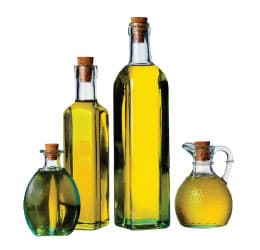Dinner Diva
The Good and the Bad of Cooking Oils
By Leanne Ely CNC
Ever since the first caveman cooked an animal over the fire, there has been cooking oil. Today there are various cooking oils used in cooking for frying, stir frying, sauteing, and in salad dressings. And as you can imagine, there are good cooking oils, those that aren’t so healthy, and some that are downright dangerous.
Cooking oils mostly come from vegetables. You’ve seen them in the stores– olive, corn, canola, soy, safflower, avocado, sesame, sunflower, grape-seed, cottonseed, peanut, walnut, almond, coconut, hazelnut and more.

Olive oil is among the healthiest of all the cooking oils. This oil offers a good balance of both monounsaturated and polyunsaturated fats. I recommend regular olive oil for cooking; extra virgin olive oil for salads and other uncooked foods. Other healthy oils fall among the nut groups including coconut. Peanut and walnut oils both have high smoking points and are best used for high heat cooking.
On the flip side are the oils that are considerably unhealthy. Canola oil shouldn’t be used for human consumption because it’s a genetically developed plant from Canada that uses the rapeseed plant as its base; a known industrial oil used for machinery and such. The word “canola” comes from the words “Canada” and “oil.” The rapeseed plant that’s used to create canola oil has been found to be toxic to humans and animals.
The worst bad oil of course is any hydrogenated or partially hydrogenated oil; these are cheap fats high in trans fats that wreak havoc in the body. These types of fats should be avoided at all costs.
The best oils are a variety of oils, the ones that are expeller or cold pressed are the healthiest. (With the exception of any olive oil, all oils should be kept in the fridge to keep their delicate fatty acids intact.) Keep in mind smoke point when cooking and remember, extra virgin olive oil should only be used in its raw state, never cooked.